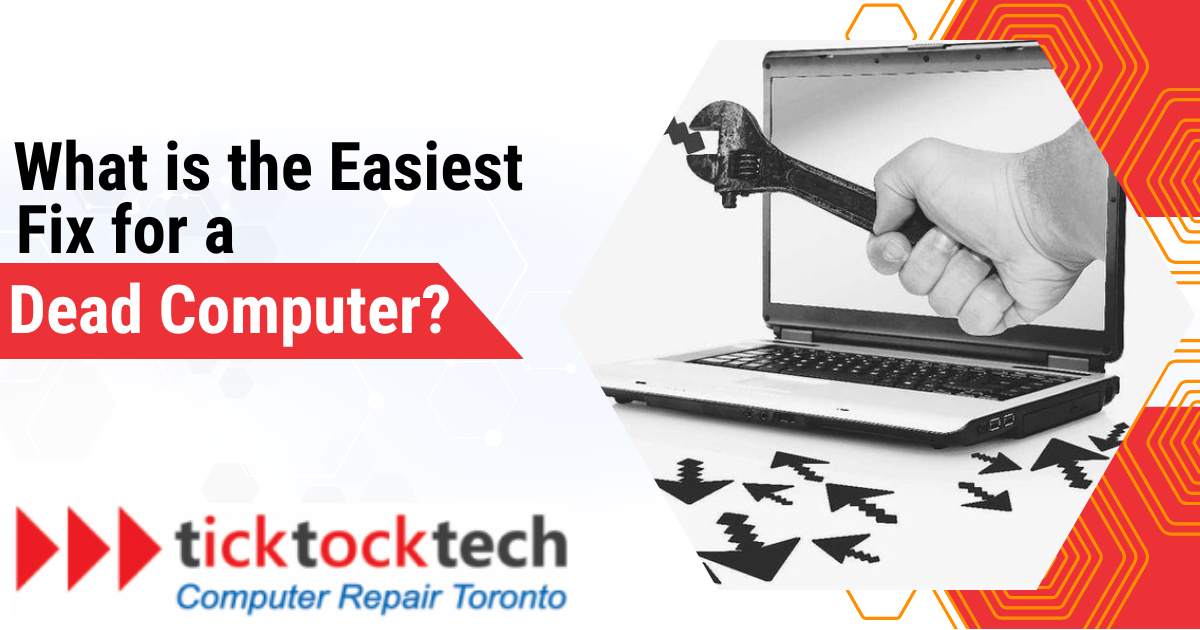The computer system, like most gadgets, can get damaged and at work, get inoperable. A computer has many issues that go wrong with, both the hardware and software. These issues can make them work less effectively, but in some extreme cases, it might make them inaccessible. The computer system can get inaccessible in many ways, either by hanging, crashing, or dying on its own without powering off. Some dead computer situations are due to a build-up of issues, like viruses. They show signs before becoming dead, while some are due to current defaults, most likely in the hardware. While some dead computers might not have any solutions, others do have possible fixes with both DIY repair techniques, and with a computer repair technician’s help. Either way, here are the possible causes of dead computers and the easiest ways to Fix them.
Can a Dead Computer be Repaired?
Depending on the root of the problem and the amount of damage, a dead computer can frequently be fixed. When a component like the power supply, RAM, or hard drive is the cause of the issue, a trained technician can typically replace or repair that component to get the computer back up and running.
The expense of repair, particularly if the computer is old or out-of-date, may be costly and not economically viable if the motherboard or other crucial components are seriously damaged. In these circumstances, it could be more sensible to think about getting a new computer.
Easiest Ways to Fix Dead Computers
To pinpoint the precise problem and assess if a fix is likely, the computer must be diagnosed. Here are the answers for the most frequent reasons for a dead body if you are unsure of how to diagnose it.
1. Get the Power Button Examined
When troubleshooting a dead computer, checking the power button is an essential first step. The issue may occasionally have its origin in a broken power button. Press the power button hard to test whether it reacts, making sure it’s not jammed or obstructed. Try using a keyboard shortcut or the power button on the display to start the computer if the button seems to be functioning. You may eliminate this potential issue and concentrate on other possible reasons why the computer won’t boot by verifying the power button’s operation.
2. Power Source Fixing
The power supply is in charge of providing the components of the computer with the required electrical power. It may be impossible for the computer to start up or result in unplanned shutdowns if the power source or power connection is broken or not working properly.
You can use a power supply tester or swap out the power supply for one that is known to function to test the power supply. A power supply tester aids in determining if the power supply is giving the components of the computer the right voltage. Replacing the power supply with a new one that is known to work will assist identify if the issue is with the power supply itself if it fails the test or if you feel it is the root of the problem.
3. BIOS/UEFI Reset
Restoring the motherboard’s firmware settings to their default configuration entails resetting the BIOS/UEFI as a troubleshooting procedure. This procedure can assist in resolving problems brought on by corrupted or inappropriate BIOS/UEFI settings. You normally need to visit the BIOS/UEFI interface during computer startup, browse to the proper option, and select to reset the settings to their default values to carry out this reset.
- Search for a tiny, coin-shaped battery on the motherboard by opening the computer casing. The CMOS battery is seen here.
- Remove the CMOS battery from its socket with care. To gently pop it out, use your fingers or a non-metallic object.
- CMOS batteries should be left out for at least five minutes. By doing so, the BIOS or UEFI can be reset to the factory defaults.
- Make sure the CMOS battery is properly seated before replacing it in the socket. Switch on the computer and close the computer case before turning it on.
- You might need to hit a certain key (often Del, F2, or F10) during the startup process to access the BIOS/UEFI settings. To access the BIOS/UEFI, see your computer’s handbook or watch for on-screen instructions.
- Find the option to “Load Default Settings,” “Load Optimized Defaults,” or anything like once within the BIOS/UEFI settings. To restore the BIOS/UEFI to its factory settings, select this option.
- Save the modifications after loading the default settings, then quit the BIOS/UEFI. The computer will restart as a result.
4. Getting Rid of Overheating
When a computer overheats, it may shut down or become unresponsive which is frequently a sign that the cooling system is malfunctioning. High temperatures can harm internal parts, reducing the computer’s overall performance and longevity. Make sure the cooling fans are operating properly and that the vents are clear and unblocked to solve this problem. In addition to preventing overheating, proper cooling will increase the computer’s stability and dependability while it is running.

5. Reset the RAM
An essential first step in reviving a dead computer is testing the RAM modules. RAM (Random Access Memory) is a crucial component that temporarily stores data for the CPU to access more quickly. The RAM may not be placed correctly or be defective, which may prevent the computer from booting or result in system problems.
Use these steps to test the RAM modules:
Unplug the computer from the power source after turning it off. To access the RAM modules, open the computer casing. Depending on the layout of your computer, you might need to take off a side panel or open a certain container.
Remove the RAM modules from their slots with caution. To remove the module and carefully take it out, apply pressure to the retention clips on either side of the module.
6. Disconnect Peripherals
External hardware, such as USB drives, printers, and external hard drives, can occasionally create problems that prevent the computer from launching correctly. You may isolate and determine which peripherals, if any, constitute the problem by disconnecting all superfluous ones.
This easy procedure can help you quickly identify the possible reasons and possibly avoid making pointless repairs or troubleshooting efforts. You can identify the offending devices and reconnect them one at a time to assist you get your computer back up and running properly if the machine boots up after you disconnect the accessories.
7. Get an Expert to help
Finding help from a trained expert or computer repair business is crucial if you’ve attempted simple troubleshooting techniques and the computer is still not working. Professionals have the knowledge and equipment necessary to diagnose complicated problems, pinpoint their causes, and offer workable remedies. If advanced issues are attempted to be fixed without the necessary understanding, it may result in more damage, making repairs much more difficult and expensive.
FAQs
The cost of repairing a dead computer varies depending on the issue and the computer’s model. Simple fixes may be relatively inexpensive, but more complex problems could be costly.
Dead computers can result from various issues, including power supply failure, motherboard damage, overheating, faulty components, or software problems.
Sudden shutdowns and failure to power on might be caused by overheating, a failing power supply, or motherboard issues. Professional diagnosis is recommended for an accurate solution.
Data recovery from a dead computer is possible in some cases, depending on the cause of the failure. However, it’s best to consult a data recovery specialist for the best chances of retrieval.
Basic troubleshooting like checking power connections and resetting the computer may help in some cases. However, if the issue is more complex, it’s best to seek professional help to avoid causing further damage.
Conclusions
In conclusion, fixing a dead computer can be possible with several troubleshooting methods. Reinstalling the operating system, checking the power button, testing the power supply, resetting the BIOS/UEFI, ensuring proper cooling, and examining RAM are some steps you can take to revive your computer. Additionally, disconnecting peripherals can help isolate potential problems. However, in complex cases, seeking the assistance of a trained expert or computer repair service is recommended to avoid further damage and ensure an effective resolution.

